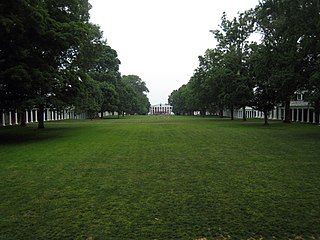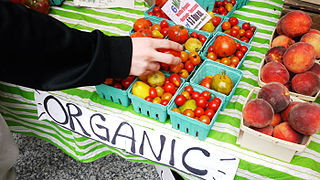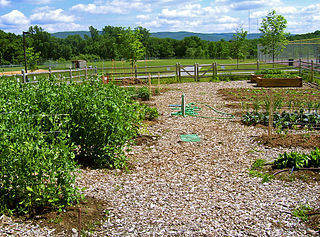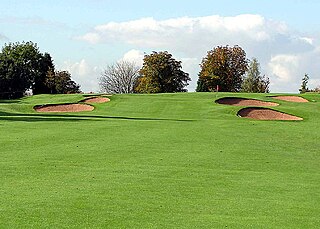
A fertilizer or fertiliser is any material of natural or synthetic origin that is applied to soil or to plant tissues to supply plant nutrients. Fertilizers may be distinct from liming materials or other non-nutrient soil amendments. Many sources of fertilizer exist, both natural and industrially produced. For most modern agricultural practices, fertilization focuses on three main macro nutrients: nitrogen (N), phosphorus (P), and potassium (K) with occasional addition of supplements like rock flour for micronutrients. Farmers apply these fertilizers in a variety of ways: through dry or pelletized or liquid application processes, using large agricultural equipment or hand-tool methods.

Organic farming, also known as ecological farming or biological farming, is an agricultural system that uses fertilizers of organic origin such as compost manure, green manure, and bone meal and places emphasis on techniques such as crop rotation and companion planting. It originated early in the 20th century in reaction to rapidly changing farming practices. Certified organic agriculture accounts for 70 million hectares globally, with over half of that total in Australia. Biological pest control, mixed cropping, and the fostering of insect predators are encouraged. Organic standards are designed to allow the use of naturally-occurring substances while prohibiting or strictly limiting synthetic substances. For instance, naturally-occurring pesticides such as pyrethrin are permitted, while synthetic fertilizers and pesticides are generally prohibited. Synthetic substances that are allowed include, for example, copper sulfate, elemental sulfur, and veterinary drugs. Genetically modified organisms, nanomaterials, human sewage sludge, plant growth regulators, hormones, and antibiotic use in livestock husbandry are prohibited. Organic farming advocates claim advantages in sustainability, openness, self-sufficiency, autonomy and independence, health, food security, and food safety.

A lawn is an area of soil-covered land planted with grasses and other durable plants such as clover which are maintained at a short height with a lawn mower and used for aesthetic and recreational purposes—it is also commonly referred to as part of a garden. Lawns are usually composed only of grass species, subject to weed and pest control, maintained in a green color, and are regularly mowed to ensure an acceptable length. Lawns are used around houses, apartments, commercial buildings and offices. Many city parks also have large lawn areas. In recreational contexts, the specialised names turf, parade, pitch, field or green may be used, depending on the sport and the continent.

The organic movement broadly refers to the organizations and individuals involved worldwide in the promotion of organic food and other organic products. It started during the first half of the 20th century, when modern large-scale agricultural practices began to appear.

A mulch is a layer of material applied to the surface of soil. Reasons for applying mulch include conservation of soil moisture, improving fertility and health of the soil, reducing weed growth, and enhancing the visual appeal of the area.

In agriculture, polyculture is the practice of growing more than one crop species together in the same place at the same time, in contrast to monoculture, which had become the dominant approach in developed countries by 1950. Traditional examples include the intercropping of the Three Sisters, namely maize, beans, and squashes, by indigenous peoples of Central and North America, the rice-fish systems of Asia, and the complex mixed cropping systems of Nigeria.

Trifolium repens, the white clover, is a herbaceous perennial plant in the bean family Fabaceae. It is native to Europe, including the British Isles, and central Asia and is one of the most widely cultivated types of clover. It has been widely introduced worldwide as a forage crop, and is now also common in most grassy areas of North America, Australia and New Zealand. The species includes varieties often classed as small, intermediate and large, according to height, which reflects petiole length. The term 'white clover' is applied to the species in general, 'Dutch clover' is often applied to intermediate varieties, and 'ladino clover' is applied to large varieties.

Organic horticulture is the science and art of growing fruits, vegetables, flowers, or ornamental plants by following the essential principles of organic agriculture in soil building and conservation, pest management, and heirloom variety preservation.

Soil conservation is the prevention of loss of the topmost layer of the soil from erosion or prevention of reduced fertility caused by over usage, acidification, salinization or other chemical soil contamination.

Groundskeeping is the activity of tending an area of land for aesthetic or functional purposes, typically in an institutional setting. It includes mowing grass, trimming hedges, pulling weeds, planting flowers, etc. The U.S. Department of Labor estimated that more than 900,000 workers are employed in the landscape maintenance and groundskeeping services industry in the United States in 2006. Of these over 300,000 workers were greenskeepers for golf courses, schools, resorts, and public parks.
This is an alphabetical index of articles related to gardening.

Natural landscaping, also called native gardening, is the use of native plants including trees, shrubs, groundcover, and grasses which are local to the geographic area of the garden.
Sand-based athletic fields are sports turf playing fields constructed on top of sand surfaces. It is important that turf managers select the most suitable type of sand when constructing these fields, as sands with different shapes offer varied pros and cons. Regular maintenance of sand-based athletic fields is just as important as the initial construction of the field. As water and other aqueous solutions are added, a layer of thatch may accumulate on the surface of the turf. There are different ways to manage this level of thatch, however the most common are aeration and vertical mowing.

Xeriscaping is the process of landscaping, or gardening, that reduces or eliminates the need for irrigation. It is promoted in regions that do not have accessible, plentiful, or reliable supplies of fresh water and has gained acceptance in other regions as access to irrigation water has become limited, though it is not limited to such climates. Xeriscaping may be an alternative to various types of traditional gardening.

Golf course turf is the grass covering golf courses, which is used as a playing surface in the sport of golf. The grass is usually maintained by a greenskeeper to control weeds, insects with pesticides, plant fungal diseases with fungicides and to introduce nutrients such as nitrogen fertilization. The grass is kept at a constant height by mowing.

Agricultural pollution refers to biotic and abiotic byproducts of farming practices that result in contamination or degradation of the environment and surrounding ecosystems, and/or cause injury to humans and their economic interests. The pollution may come from a variety of sources, ranging from point source water pollution to more diffuse, landscape-level causes, also known as non-point source pollution and air pollution. Once in the environment these pollutants can have both direct effects in surrounding ecosystems, i.e. killing local wildlife or contaminating drinking water, and downstream effects such as dead zones caused by agricultural runoff is concentrated in large water bodies.
Sustainable landscaping is a modern type of gardening or landscaping that takes the environmental issue of sustainability into account. According to Loehrlein in 2009 this includes design, construction and management of residential and commercial gardens and incorporates organic lawn management and organic gardening techniques.

Climate-friendly gardening is a form of gardening that can reduce emissions of greenhouse gases from gardens and encourage the absorption of carbon dioxide by soils and plants in order to aid the reduction of global warming. To be a climate-friendly gardener means considering both what happens in a garden and the materials brought into it as well as the impact they have on land use and climate. It can also include garden features or activities in the garden that help to reduce greenhouse gas emissions through processes not directly related to gardening.
Necrotic ring spot is a common disease of turf caused by soil borne fungi that mainly infects roots (4). It is an important disease as it destroys the appearance of turfgrasses on park, playing fields and golf courses. Necrotic Ring Spot is caused by a fungal pathogen that is an ascomycete that produces ascospores in an ascocarp (6). They survive over winter, or any unfavorable condition as sclerotia. Most infection occurs in spring and fall when the temperature is about 13 to 28 °C (5). The primary hosts of this disease are cool-season grasses such as Kentucky bluegrass and annual bluegrass (6). Once turf is infected with O. korrae, it kills turf roots and crowns. Symptoms of the disease are quite noticeable since they appear as large yellow ring-shaped patches of dead turf. Management of the disease is often uneasy and requires application of multiple controls. The disease can be controlled by many different kind of controls including chemicals and cultural.

A clover lawn is composed of clover and can be used as an alternative to grass lawns. It requires less maintenance than a traditional lawn and utilizes less water. It is also more heat tolerant. White clover is the plant most frequently used. Red clover may also be used.
























